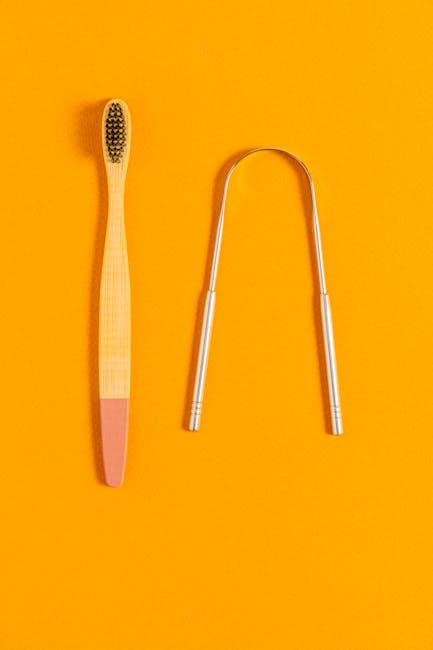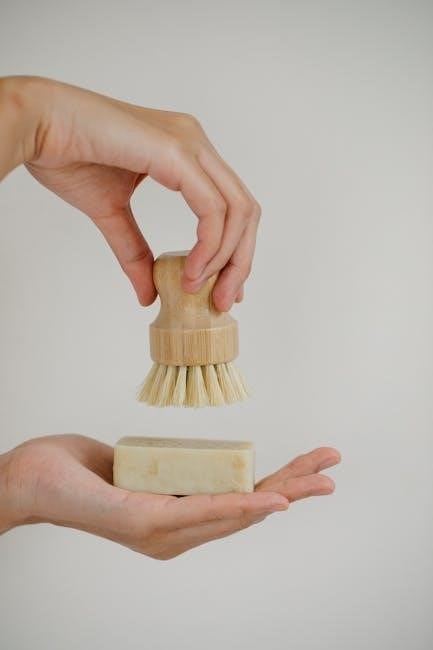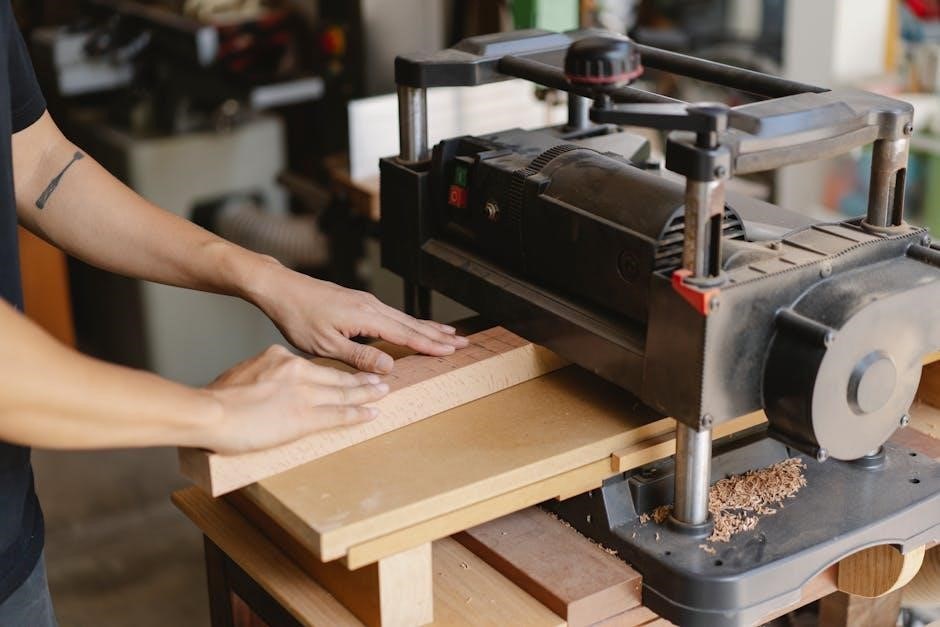Discover free PDF plans for building durable, customizable wooden tool chests. Perfect for organizing tools, these designs offer classic aesthetics and modern functionality for all woodworkers.
Overview of Tool Chests and Their Importance
Tool chests are essential for organizing and protecting tools, enhancing workshop efficiency. Wooden chests offer durability and aesthetic appeal, making them a popular choice. They provide secure storage, keep tools within reach, and protect them from damage. Building a wooden tool chest allows for customization to meet specific needs. Free PDF plans simplify the process, ensuring accessibility for woodworkers of all skill levels. A well-crafted tool chest is a valuable investment for any workshop.
Why Choose Wooden Tool Chests?
Wooden tool chests combine durability and classic aesthetics, offering a timeless appeal; They provide excellent protection for tools, are customizable to fit specific needs, and often feature a professional, handcrafted look. Wood is also generally lighter than metal, making chests more portable. With proper care, wooden chests can last for years, making them a practical and stylish choice for workshops and garages. Their natural beauty enhances any workspace.
Free PDF Plans Availability and Benefits
Free PDF plans for wooden tool chests are widely available online, offering a cost-effective way to start your woodworking project. These plans provide detailed instructions, material lists, and diagrams, making it easier for DIY enthusiasts to build custom tool chests. They cater to various skill levels, from simple designs to complex builds. Downloading free PDF plans allows you to save money, explore different styles, and customize the project to fit your specific needs and workspace requirements.
Materials and Tools Required
Essential materials include plywood, wood glue, nails, and aluminum rivets. Basic tools like saws, drills, and sanders are necessary for construction, ensuring a sturdy and functional tool chest.
Essential Woodworking Materials for Tool Chests
Plywood or solid wood is ideal for the chest’s structure, while MDF can be used for drawer bottoms. Hardware includes hinges, drawer slides, and locks. Sandpaper and wood stain or paint are necessary for finishing. Nails, screws, and wood glue ensure durability. Aluminum rivets add strength for lightweight designs. Proper materials ensure a sturdy, functional, and visually appealing tool chest, whether for classic or modern designs.
Basic and Advanced Tools Needed for Construction
Basic tools include a table saw, sanders, and drills for cutting and smoothing wood. Advanced tools like jigsaws and drill presses enhance precision. Clamps, chisels, and measuring tools are essential for assembly. Optional power tools, such as routers and planers, add professional finishes. Hand tools like hammers and screwdrivers are versatile. While power tools speed up the process, hand tools can achieve similar results with practice and patience, ensuring a sturdy and well-crafted tool chest.

Step-by-Step Guide to Building a Wooden Tool Chest
Start by planning the design and gathering materials. Cut wood according to plans, assemble the base, add walls, and attach the lid. Sand, finish, and ensure secure closure for durability and functionality.
Preparing the Wood and Cutting the Components
Begin by selecting and preparing high-quality wood, ensuring it is dry and free of defects. Measure and mark each component according to your plan. Use a table saw or circular saw to make precise cuts for the chest’s base, sides, and lid. Sand all edges to ensure smooth finishes. Apply glue to joints and clamp firmly, allowing the adhesive to cure. Drill pilot holes for nails to prevent wood splitting during assembly.
Assembling the Chest and Lid
Start by assembling the chest’s base and sides using nails and wood glue, ensuring all corners are square. Attach the back and front panels, then secure the top frame. For the lid, construct a separate frame and attach it with hinges for easy access. Sand all surfaces for a smooth finish before adding a protective coat of varnish or paint. Ensure proper alignment to guarantee the lid opens and closes seamlessly.
Adding Drawers and Organizational Features
Install drawers by attaching slides to the chest’s interior and drawer sides for smooth operation. Use dividers or trays to maximize storage capacity. Customize compartments to fit specific tools, ensuring easy access. Add drawer pulls or handles for convenience. Consider incorporating adjustable shelves or small trays for additional organization. These features enhance functionality, making the tool chest tailored to your workshop needs while maintaining a clutter-free environment.

Design Variations and Customization Options
Explore various designs, from classic to modern, and customize your tool chest with drawers, shelves, or compartments. Add wheels for portability or personal touches like engravings.
Classic vs. Modern Designs
Classic wooden tool chests often feature dovetail joints and simple, timeless aesthetics, ideal for traditional workshops. Modern designs incorporate sleek lines, additional compartments, and mobility features like wheels, blending functionality with contemporary style. Both options offer durability and customization, allowing woodworkers to choose based on personal preference and workshop needs. Free PDF plans cater to both styles, ensuring versatility for all skill levels.
Personalizing the Tool Chest for Specific Needs
Customize your tool chest to fit your unique requirements by adjusting size, adding compartments, or incorporating specialized features. Woodworkers can modify free PDF plans to include drawers, trays, or dividers, ensuring optimal tool organization. Personal touches like locks or wheels enhance functionality. Whether for a hobbyist or professional, personalizing the design ensures the chest meets specific needs, improving workshop efficiency and tool accessibility. This versatility makes wooden tool chests adaptable to any workspace or preference.

Advanced Features for Enhanced Functionality
Fixing Warped or Misaligned Lids
Use clamps and shims to realign lids. Sand warped areas for even surfaces. Ensure hinges are securely fastened for proper functionality, maintaining the chest’s structural integrity and usability.
Adding Locks and Security Measures
Enhance your tool chest’s security by installing sturdy locks or latches. Consider padlocks, built-in locks, or digital solutions for added protection. Reinforce the lid and hinges with metal brackets to prevent tampering. For portability, add wheel locks to secure the chest in place. These features ensure your tools remain safe and accessible only to authorized users, protecting your investment from theft or accidental damage. Proper installation is key to maintaining durability and functionality.
Incorporating Wheels for Portability
Add mobility to your wooden tool chest by installing sturdy wheels. Heavy-duty casters or ball-bearing wheels ensure smooth movement across workshops or job sites. Mount wheels to the base for easy maneuverability without compromising storage capacity. Reinforce the frame to handle the added stress of rolling. This feature is ideal for professionals needing to transport tools efficiently, making your tool chest both functional and convenient for various work environments.
Installing Dividers and Trays
Enhance organization by adding dividers and trays to your wooden tool chest. Use adjustable dividers to separate tools of different sizes, ensuring easy access. Incorporate removable trays for small items like screws or bits. This customization maximizes storage efficiency and keeps your workspace clutter-free. Many free PDF plans include templates for these features, making it simple to tailor your tool chest to your specific needs and preferences.
Safety Tips and Best Practices
Ensure safety by drilling pilot holes and using clamps to prevent splitting. Proper alignment and stability are crucial during construction to avoid accidents.
Preventing Wood Splitting During Construction
Drill pilot holes before nailing to avoid wood splitting. Use clamps to hold pieces securely, ensuring even pressure. Apply glue carefully to ends and edges, avoiding excess. When assembling, nail gradually, starting from the center to prevent uneven stress. Sand surfaces beforehand for better adhesion and reduced risk of cracks. Always pre-drill screw holes to maintain structural integrity and prevent splintering during construction.
Ensuring Proper Alignment and Stability
Use clamps to hold components firmly in place during assembly. Measure twice and cut once to ensure precise fitting. Check the squareness of corners using a carpenter’s square. Pre-drill holes for screws to maintain alignment. Apply even pressure when nailing to prevent shifting. Use a level to ensure the chest sits flat. Gradually tighten all screws to avoid warping. Proper alignment ensures stability and durability, making the tool chest both functional and long-lasting.

Free PDF Plans and Resources
Access free PDF plans for wooden tool chests, featuring step-by-step guides, material lists, and customizable designs. Ideal for DIY enthusiasts and professionals seeking efficient tool organization.
Top Websites Offering Free Tool Chest Plans
Popular websites like ToolCrib, Woodsmith, and Instructables provide free PDF plans for wooden tool chests. These sites offer detailed instructions, material lists, and customizable designs. ToolCrib features lightweight, portable options, while Woodsmith offers classic machinist designs. Instructables includes creative DIY projects with step-by-step guides. These resources cater to both beginners and experienced woodworkers, ensuring efficient tool organization and durability for various workshops.
Downloading and Using PDF Templates Effectively
Download free PDF templates from trusted sites like Woodsmith or ToolCrib. Print and review plans before starting your project. Use software to customize dimensions or features. Ensure all materials are listed and prepare tools in advance. Follow step-by-step instructions for precise cuts and assembly. Consider adding personal touches like dividers or locks. Store completed plans digitally for future reference or sharing with fellow woodworkers.

Popular Wooden Tool Chest Plans
Explore free PDF plans for rolling tool chests and classic designs. These versatile plans cater to various woodworking skill levels, offering portability and timeless style for tool organization.
Simple Hand Tool Chest Plans
Simple hand tool chest plans are perfect for beginners, offering easy-to-follow instructions for building compact, portable storage solutions. These designs require basic materials like plywood and essential tools, ensuring affordability and accessibility. With a focus on functionality, these plans often include features like removable trays and dovetailed joints for durability. Ideal for small tool collections, they provide easy access and organization, making them a great starting point for woodworking projects.
Rolling Tool Chest Plans for Workshop Efficiency
Rolling tool chest plans enhance workshop efficiency by combining portability with ample storage. Designed for easy mobility, these chests often feature sturdy wheels and a compact frame, allowing seamless movement around the workspace. Many plans include drawers or trays for organized tool access, while others offer customizable layouts to suit specific needs. Built with durable materials like plywood and aluminum, these chests are both lightweight and robust, ensuring years of reliable service. Free PDF plans provide detailed instructions, making it easy to construct a rolling tool chest tailored to any workshop setup.

Maintenance and Upkeep
Regularly clean and protect the wooden surface with oil to prevent damage. Address scratches or dents promptly to maintain functionality and extend the tool chest’s lifespan.
Cleaning and Protecting the Wooden Surface
Regularly clean the tool chest with a soft cloth and mild detergent to remove dirt and grime. Avoid harsh chemicals that may damage the wood. Dry thoroughly after cleaning to prevent moisture damage. Apply a wood oil or wax periodically to protect the surface and maintain its finish. For tougher stains, lightly sand the area before reapplying finish. Inspect the chest regularly for signs of wear and address them promptly to ensure longevity.
Replacing or Repairing Damaged Parts
Assess damaged areas to determine if replacement or repair is needed. For loose joints, apply wood glue and clamp tightly until dry. Cracks or splits can be filled with wood filler, sanded smooth, and refinished. Replace severely damaged panels or drawers by following the original plans. Use pilot holes to avoid splitting wood when reinstalling parts. Regular inspections and timely repairs will extend the tool chest’s lifespan and maintain its functionality and appearance.

Comparison with Metal Tool Chests
Wooden tool chests offer a lighter, quieter, and more aesthetically pleasing alternative to metal. They are often more cost-effective and environmentally friendly, though metal may be more durable in heavy-duty settings.
Advantages of Wooden Tool Chests Over Metal
Wooden tool chests are lighter, quieter, and more aesthetically pleasing than metal ones. They are often more affordable and environmentally friendly, with natural beauty that enhances workshops. Wood offers better thermal insulation and can be easily customized. Unlike metal, wood doesn’t rust or dent, making it a durable choice for long-term use. Additionally, wooden chests are less prone to causing tool damage from sharp edges, providing a safer storage solution for valuable tools.
When to Choose Metal Over Wood
Metal tool chests are ideal for heavy-duty use, offering superior durability and resistance to heavy loads. They are fire-resistant and often feature smooth, ball-bearing drawers. Metal chests are best for industrial settings or when extreme sturdiness is needed. However, they can be noisy and prone to rust. Choose metal for high-security requirements or when longevity under harsh conditions is a priority, despite their higher cost and less aesthetic appeal compared to wood.

Troubleshooting Common Issues
Address warped lids by adjusting hinges or sanding uneven surfaces. Fix drawer alignment by tightening slides or lubricating tracks. Free PDF plans often include repair tips for these challenges.
A warped or misaligned lid can disrupt tool chest functionality. Check hinges for proper alignment and tighten loose screws. Sand uneven surfaces to ensure a flush fit. Apply wood shims or adjust the lid’s frame to correct warping. Ensure the chest is level and stable before reattaching the lid. Free PDF plans often include troubleshooting tips for common issues like these, providing step-by-step solutions for a secure, even closure.
Addressing Drawer Sliding Problems
Drawer sliding issues can hinder tool chest efficiency. Inspect drawer slides for debris and lubricate with wax or oil. Adjust alignment screws to ensure proper fit. Sand rough wood surfaces to reduce friction; Replace worn-out slides if necessary. Free PDF plans often include tips for optimizing drawer performance, ensuring smooth operation and maximizing storage accessibility in your wooden tool chest.

Upcycling and Repurposing Old Tool Chests
Breathe new life into old tool chests by transforming them into storage units or decorative pieces. Free PDF plans offer creative ways to repurpose wood, reducing waste and crafting unique items for home or workshop use.
Transforming an Old Chest into a Storage Unit
Upcycle an old tool chest into a functional storage unit by refinishing or repainting it. Add dividers or trays for organization, turning it into a versatile space-saving solution for your home or workshop. This creative approach breathes new life into discarded items, reducing waste while creating a unique, practical piece for everyday use.
Creative Ways to Repurpose Wood from Old Chests
Repurpose wood from old chests into unique projects like birdhouses, picture frames, or shelves. Sand and refinish the wood to create decorative items such as coasters or wall art. Consider crafting custom tool trays or small storage boxes. This eco-friendly approach reduces waste and gives old materials new life, perfect for woodworking enthusiasts looking to add a personal touch to their creations.